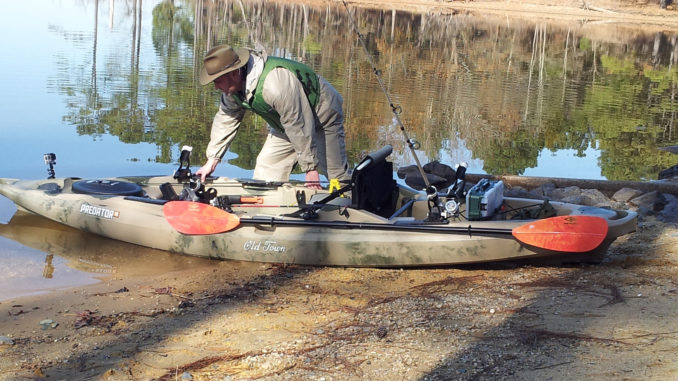
Dress wisely for a paddle-fishing outing
The highs were expected to reach the lower 50s, with little to no wind. Deer season had passed, and duck hunting was pretty much restricted to Saturdays. With such a beautiful winter day on the way, the itch to get outdoors was just overwhelming.
Hmm. The crappie are piled up under the bridges. It has been several months since the fishing gear had been wet. What the heck, a fishing day it is.
We get a few of these days each winter, and it is a shame to let them pass. In order to pull out the kayak, you have to wear the proper gear, or the day may become memorable for a reason other than a cooler full of slabs.
Why do you need cold-weather protection?
Most paddling sports will get you wet. It does not matter whether it is a canoe, traditional kayak or sit-on-top kayak, water will splash, run down the paddle or breach the side of the craft at some point. Bodily activity can combat cold from general wetness, but the only parts of the body easily movable while floating are the arms.
In the unfortunate circumstance that the craft may capsize, water immersion drops the body’s core temperature much faster than air, and water temperatures in the 50s can be deadly in a relatively short amount of time. If water temperatures are in the 30s, you can die in under 15 minutes.
On average, nearly 20 percent of people die in freezing waters within the first 2 minutes due to cold shock. Rapid breathing and panic can cause water inhalation and cardiac arrest. If the victim can survive the initial cold shock, the next 15 minutes brings incapability of the hands, arms and legs due to the body trying to conserve energy to heat up the body’s core, causing drowning. Exhaustion and unconsciousness finishes the job.
Cold, wet feet can make for a miserable day. The solution is simple: wool socks. In fact, wear two pairs if the weather is really cold. There are many types of wool undergarments available that can make a nice base layer. The reason wool works is it can maintain warmth even when wet. Cotton, on the other hand, is the exact opposite.
You can even take the wool top and pants set that hunters often use and cover it with a waterproof or water-resistant suit such as those made by Frog Togs. It is plenty movable, so you can handle the paddle, rods and reels and still feel comfortable with the life vest on.
Scuba divers and water skiers have long used wetsuits. They come in a variety of designs, from shorties — a suit covering just the body’s trunk — to full-length suits that include head gear. The wetsuit is made of a neoprene, which allows water to enter the suit. The body quickly warms the water between itself and the wetsuit to provide additional insulating layer.
Dry suits take it a step further. They are suits that keep the body dry, even in water. Most cold-rated dry suits are very expensive, but there are other partial dry suits available at decent prices, and many outdoorsmen already have one.
Chest waders are one of the most common of these partial suits. While they come in a variety of thicknesses and compositions, you still want to dress according to the temperature. A thin set of waders commonly used for something like trout fishing will not be your best choice on a below-freezing day. Likewise, 6mm neoprene duck hunting waders with several layers of wool beneath them are not the best choice on a day when temperatures are expecting to reach the mid-60s. While dressing in layers works great for hunting, it is much harder to shed or add clothing while sitting in a kayak with average stability and less storage.
Your hands are likely the most susceptible to cold water. They are on the paddle, and even with the drip rings, water will get to them. Add in the fact that you hope to land a few fish, and your hands need care. There are several kinds of gloves that can protect your hands from the cold, or if you prefer the feel of your equipment with gloves, you can pack a dry towel and hand warmers. Keep the towel — a dish towel works well — in a freezer bag for drying your hands. Keep the hand warmers in a life-vest pocket so you can grab and hold them at any time.
Since the paddle handle is the most obvious and frequent place your hands will be, wrap the handle with waterproof tape to insulate the hands from the handle.
Heat rises, and body heat leaves quickly through the top of the head. A hat is an obvious choice, as well as a knitted cap. Again, wool works the best for the cap. As far as a hat, a felt or leather hat traps heat very well. On a windy day, a balaclava even offers a break from the cold for the face.
While the fish may still bite when the weather turns cold, the key is to be safe while fishing. It is a lot more fun when you are warm and protected then wet and shivering.



Be the first to comment